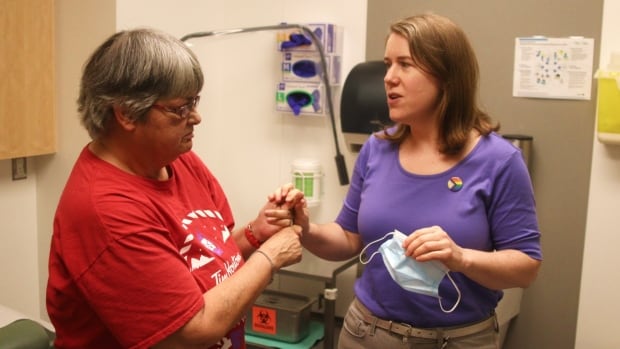white coat black art26:30The secret to success in community health centers
Staff at the Centretown Community Health Center near downtown Ottawa see a variety of patients every day, from the homeless to the elderly to families with young children who are struggling to find a family doctor. Masu.
Similar to the school district, the idea is that anyone who lives in that area, which includes Glebe, Centertown and Old Ottawa South, would automatically be eligible for the center’s services. This is an attempt to bridge the gap in a state with a population of more than 2 million people. Without primary care.
But now, like primary care offices across the country, it is grappling with its own capacity issues. Community health centers (CHCs) aim to make more efficient use of existing staff to address some of these issues, but advocates are calling on the Department of Health to provide more team-based care. We urge them to expand their efforts to provide this.
Clinic staff and other primary care providers say the rest of Canada has much to learn from Centretown’s model of collaborative, comprehensive care and location-based access to family physicians. talk.

Unlike a family physician’s office, which provides only primary care, the CHC model teams family physicians with other health professionals such as nurses, social workers, and dietitians. This allows doctors to focus on medical care while allowing patients to access a variety of treatments under the same roof.
Centertown was founded in 1969 as Ontario’s first community resource center and became a community health center in 1974.
Users can access a variety of services, from harm reduction and showers for the unhoused, to mental health services, assistance finding emergency shelter, and early childhood programs for families with children under 5.
Community health workers, nutritionists, and physical therapists are also on-site.
The center’s mission is to meet the health and social needs of clients who are complex and may have conditions such as: turned away by doctor Limited to standard short appointments.
“If they’re too complex, we say, ‘Yes, we’re the place to serve you,'” says Michelle Furtubiz, the clinic’s executive director.

It is also one of the few primary care practices in Ottawa that provides gender-affirming care to transgender people.
Avoid headaches for small businesses with family-friendly documentation
Another unique aspect of Centertown’s model is the way the clinic is staffed. Unlike traditional family practices, where physicians typically function like small businesses, with high overhead costs and significant administrative responsibilities such as hiring and firing, CenterTown is established as a nonprofit organization and has full- and part-time staff. He has more than 220 doctors. When doctors and nurses are employees of the center.
“I don’t want to be a small business owner. I want to do what I was trained to do, which is to be a clinician,” said Dr. Erin Hansen, one of Centertown’s internists.

Physicians are also paid differently than paid physicians and are given a stable income plus pensions and benefits.
This difference has made adoption much easier, Furtubise says. While family practice resident and staff positions are filled in other parts of the country, “we’ve been lucky that we haven’t really had a hard time recruiting,” she said.
Family physicians Dr. Camilla Premji and Dr. Rita McCracken discuss the shortage of family physicians in Canada and what can be done to alleviate the situation.
Centertown is largely funded by the Department of Health, with 85% of its funding coming from the state.
Responding to important needs that have been responded to all over the countryCentertown doctors point to a large patient list of nearly 15,000 clients and health outcomes as evidence that the medical model is working.
A team-based approach to care
Currently about 120 CHCs across Canada, new ones are also in development. This model is part of the changing landscape of frontline medicine, where many doctors claim to put patients first.
“I think a team-based approach provides what’s best for our clients because they get the services they need when they need them,” says Centertown physician Dr. Alison Eyre.
We prevent limb amputation, retinopathy, high blood pressure, and high blood pressure, making it a very cost-effective model.– Michelle Heartbiz
She pointed to the clinic’s ability to quickly provide tailored services to patients, including immunizations, social workers and outreach nurses. “Most of our service fees are [clinics] We don’t have access to those resources,” she says.
Hartubiz also said CCHC has had “overall positive outcomes” for clients when it comes to issues such as diabetes, blood pressure management and smoking cessation. “That means significant savings in health care costs,” she says.
For example, people with diabetes who use CHC can see a dietitian covered by OHIP to help control their blood sugar levels, as well as a chiropractor who treats foot orthotics and other necessary services. She says you can talk to other medical professionals who have sex with you.
“We’re preventing limb amputations, retinopathy, high blood pressure, high blood pressure, and it’s a very cost-effective model,” she said.
Additionally, physicians may experience a smoother referral process because they know they are sending patients to a specialist with experience in vulnerable or underserved areas.
“I think team-based care leads to better outcomes,” said the Alliance for Health, a research program that helps determine how Ontario’s health care system can better serve vulnerable populations.・Dr. Jennifer Rayner, director of research and evaluation at HealthA Community, agrees.

Rayner also believes places like Centertown have the potential to reach communities that are overlooked in the medical field.
She said, “Many evidence“Facilities like Centertown support communities that are not often seen elsewhere. That will reduce the amount of emergency room visits in those communities.
“We found that CHCs serve a population that is 70 per cent more complex than the average Ontarian, yet they visit the emergency room less often,” she says.
Researchers too found Emergency department visit rates for CHC clients were 21 percent lower than expected compared to the state average.

Dr. Andrew Bouzary, a primary care physician and executive director of population health and social medicine at the University of Toronto Health Network, agrees. He says his CHC in Canada regularly admits more racialized and low-income patients than traditional clinics.
“There is no risk adjustment or incentive for family health teams to take on sicker, poorer, more racialized patients,” he said.
That’s why “there’s often a mismatch between where the medical need is and the type of primary care,” he says. Resources that are made available. ”
There are two sides to the family health crisis that deeply impact us all. Nick Pardon meets an elderly patient in rural Ontario who has been looking for a family doctor for a year, and an overwhelmed family doctor who admits there is something missing in his patients.
Hansen says that’s definitely the case for patients like Amanda Massia who would otherwise have a hard time finding appropriate care.
“Amanda is on a fixed income. Amanda has significant medical and mental health issues and is a smoker. So drug use is also part of her problem,” she says.
For Macia, the care she receives at Centertown is “very, very important.” She has been in and out of mental health facilities for most of her life, and says she prefers CCHC’s approach. “It’s not good to be locked up in a ward. It’s much better to be free and be able to go into a ward and talk to someone,” she says.

At Centertown, Massia receives what’s called comprehensive primary health care, which is different from standard primary care, Dr. Hansen said. She believes that primary care is disease management, but primary health care also includes health promotion and disease prevention.
The center has reached its maximum value
But even Centretown is not immune to certain capacity issues that often impede Canadians’ pursuit of family care.
“Unfortunately, we are at capacity,” said Furtubize of the clinic. He continues to work with drop-in services such as mental health and addictions, but when it comes to family doctors, even people who live in catchment areas are being turned away.
“Unfortunately, we are in the Center Town CHC catchment area and, although we have tried in the past, we are well known for not accepting new patients,” said Carolyn Inch, a senior living in Ottawa. He says this while considering the town model. It’s better than her traditional paid service provider, but so far she hasn’t been able to access that service. “We need to completely rethink our approach to healthcare,” she says.
Mr. Hurtubiz understands Mr. Inch’s frustration. “Some of the conversations we’re having are; [are] “So what can we do in our own systems to increase capacity? How can we improve our own efficiency?” she says.








